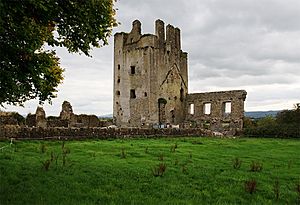Kilcash Castle facts for kids
Quick facts for kids Kilcash Castle |
|
|---|---|

Kilcash Castle ruin
|
|
| Location | 5 miles (8 km) east of Clonmel, County Tipperary, Ireland |
| Built | 16th century |
| Lua error in Module:Location_map at line 420: attempt to index field 'wikibase' (a nil value). | |
Kilcash Castle is a castle in ruins located near the N24 road, west of Ballydine in County Tipperary, Ireland. The Irish government looks after it. The powerful Butler dynasty family had strong connections to this area for a long time.
Contents
History of Kilcash Castle
The main part of Kilcash Castle is a strong tower built in the 1500s. Later, a hall was added next to it. This new part had big windows, showing that the area was more peaceful then. In the 1500s, the Kilcash area became part of the Butler family's lands. The Butlers of Ormond owned it. In 1997, they sold the castle to the Irish government for £500.
In 1614, Walter, the 11th Earl of Ormond, lived at Kilcash. He became the Earl of Ormond after his uncle, Thomas, passed away. There was a disagreement over who owned the Ormond lands. Walter was even put in prison in London from 1619 to 1625. This happened because James VI and I, the king, tried to make him give up most of his property. Walter later gave the Kilcash lands to his grandson, Colonel Richard Butler of Kilcash (who died in 1701).
The 3rd Earl of Castlehaven often stayed at Kilcash. He was a famous commander for the Irish Catholics during the wars from 1641 to 1652. His sister, Lady Frances, was married to Richard of Kilcash, who was also a commander. Lord Castlehaven wrote his memories there. These were later published as The Earl of Castlehaven's Review.
In the 1800s, the castle started to fall apart. This happened after parts of the Kilcash Estate were sold around 1800. During the Irish Civil War, soldiers who were against the peace treaty took over the castle. They wanted to slow down the soldiers who supported the treaty, who were moving towards Clonmel. The anti-treaty forces were eventually forced out by cannon fire. This was led by Commandant-General John T. Prout. The fighting caused even more damage to the already old castle.
By the late 1900s, the castle was in very bad condition and was dangerous. Starting in 2011, a lot of repair work was done to stop the castle from collapsing.
Kilcash Church and Graveyard
Near the castle, you can find the remains of a medieval church. A medieval church is a church built a long time ago, during the Middle Ages. This church has two main parts: a chancel and a nave. It also has a beautiful Romanesque doorway on its south wall. Romanesque is a style of architecture from the Middle Ages. This church was partly fixed in the 1980s and is now open for people to visit.
In the graveyard next to the church, there is a large building called a Butler mausoleum. A mausoleum is a building that holds tombs or graves. This one is almost as big as the church itself! It contains the tombs of several important people from the Butler family:
- Thomas Butler of Garryricken
- Christopher Butler (1673–1757), who was a Roman Catholic Archbishop of Cashel. He was a younger brother of Thomas Butler of Garryricken.
- Margaret Magennis, Viscountess Iveagh (1673–1744). She was the wife of Bryan, 5th Viscount Magennis, and later of Thomas Butler.
- Walter Butler, 16th Earl of Ormonde (died 1773)
- John Butler, 17th Earl of Ormonde (died 1795)
Some of the gravestones from the 1700s have detailed carvings. These carvings often show scenes of the crucifixion.
The Famous Song "Kilcash"
Kilcash Castle is very well known because of a sad song called "Kilcash" (Irish: Cill Chaise). The song talks about the castle falling into ruins and the death of Margaret Magennis, Viscountess Iveagh. Many people thought the song was written by a priest named Fr John Lane (who died in 1776). However, the woods mentioned in the first part of the song were not sold until 1797 and 1801. This was long after Fr Lane had passed away. The oldest copies of the poem that we have are from the mid-1800s.
Here is the first part of the song in Irish, and then its English translation:
- Cad a dhéanfaimid feasta gan adhmad?
- Tá deireadh na gcoillte ar lár;
- níl trácht ar Chill Chais ná ar a teaghlach
- is ní chluinfear a cling go bráth.
- An áit úd a gcónaíodh an deighbhean
- fuair gradam is meidhir thar mhnáibh,
- arlaí ag tarraingt tar toinn ann
- is an t-aifreann binn á rá.
- Now what will we do for timber,
- With the last of the woods laid low?
- There's no talk of Cill Chais or its household
- And its bell will be struck no more.
- That dwelling where lived the good lady
- Most honoured and joyous of women
- Earls made their way over wave there
- And the sweet Mass once was said.
(translation by Eiléan Ní Chuilleanáin)
Images for kids



